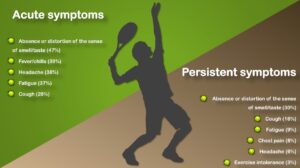Author: Ítalo Ribeiro Lemes, Bruno Gualano
Applied Physiology & Nutrition Research Group; Laboratory of Assessment and Conditioning in Rheumatology; Faculdade de Medicina FMUSP, Universidade de São Paulo, São Paulo, Brazil

Athletes very often experience mild COVID-19; however, they may still develop persistent symptoms that affect health, performance, and return-to-play decisions. In this blog, we will explain the key findings of our systematic review and meta-analysis, recently published in BJSM.
Why is this study important?
Although some studies have shown that most COVID-19 infections in athletes are asymptomatic or result in a mild form of the disease, little was known on the prevalence, features, and persistence of symptoms in this population. A better understanding of how COVID-19 presents itself in athletes is essential to inform safe return-to-sport protocols, as well as to allow adequate screening and monitoring of potentially at-risk individuals. In this study, we systematically reviewed the literature on male and female athletes diagnosed with COVID-19, across 15 countries, from amateur to professional sports.
How did the study go about this?
We conducted a systematic search in different databases and extracted data on acute and persistent symptoms (during and after the acute phase of infection). These studies included professional, amateur, and collegiate athletes with COVID-19. We calculated the combined estimates of asymptomatic, mild, moderate, and severe cases, as well as estimates for type of acute and persistent symptoms and cardiac involvement.
What did the study find?
A total of 43 studies with 11,518 athletes were analysed. The rate of asymptomatic COVID-19 was 25.5%, while the rates of mild, moderate, and severe forms of the disease were 68.6%, 6.7%, and 1.3%, respectively. The most common acute symptoms were absence of the sense of smell, distortion of the sense of taste, fever/chills, headache, fatigue, and cough.
The rate of persistent symptoms was 8.3% (with a 95% confidence interval ranging from 3.8 to 17.0%), and the most prevalent ones were absence of the sense of smell, distortion of the sense of taste, cough, fatigue, chest pain, headache, and exercise intolerance.
Some cardiac abnormalities were present in 5% of the athletes who had undertaken cardiac assessments, and in 2.5% among those who had undergone magnetic resonance imaging (MRI). However, clinical symptoms were not well characterised in some of these reviewed studies, so that the clinical applications of such cardiac findings are questionable. In reality, none of the studies using control parameters (e.g., non-infected athletes, pre-infection assessments) could confirm a causal relationship between COVID-19 and cardiac involvement.
What are the key take-home points?
As confirmed by this study, the vast majority of the infected athletes (~94%) have mild or no acute COVID-19 symptoms. Yet, this review also demonstrates that a variable proportion of them may experience persistent symptoms – some of them being potentially performance-debilitating (e.g., fatigue, exercise intolerance). This may impact the decision-making process of returning the affected athlete to practice or competition.
Of note, the available evidence could not confirm a causal relationship between COVID-19 and cardiac involvement in athletes. The axiom “absence of evidence is not evidence of absence” is sometimes a cliché, but can be very well applied to this context, since just a few studies have used adequate controls and diagnosis criteria while assessing myocarditis in athletes.